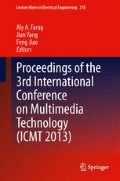Abstract
The high complexity of the maximum likelihood (ML) multi-user detection (MUD) restricts its application. The linear detector is a suboptimal algorithm with lower complexity, which is also the basis and criterion of many other algorithms, such as interference cancellation algorithms and adaptive receiver. In order to avoid the stochastic matrix inversion, which is the critical part of the conventional detector, a novel simplify algorithm, which has the same performance compare with the conventional detector but lower complexity, is proposed in this paper. And lower complexity linear equalizers can be derived by using the similar method.
Access this chapter
Tax calculation will be finalised at checkout
Purchases are for personal use only
References
Schneider KS (1979) Optimum detection of code division multiplexed signals. IEEE Trans Aeros Electron Syst AES 15(1):181–185
Imai KRH, Hatori M (1983) Cancellation Technique of Co-channel interference in Asynchronous Spread Spectrum Multiple Access system. ICICE Trans Comm 65-A:416–423
Verd S (1986) Minimum Probability of error for asynchronous gaussian multiple-access channels. IEEE Trans Inform Theory IT-32:85C96
Verd S (1989) Computational complexity of optimal multiuser detection. Algorithmica 4:303–312
Lupas R, Verd S (1989) Linear multiuser detectors for synchronous code-division multiple-acess channels. IEEE Trans Inform Theory 35:123–136
Lupas R, Verd S (1990) Near-far resistance of multiuser detectors in synchronous channels. IEEE Trans Commun 38:496–508
Varanasi MK, Aazhang B (1990) Multistage detection in asynchronous code-division multiple-acess communications. IEEE Trans Commun 38:509–519
Divsalar D, Simon M, Raphaeli D (1995) Improved parallel interference cancellation for CDMA. IEEE Person Commun 2(2):46–58
Recommendation ITU-RM.1225 (2000) Guidelines for evaluation of radio transmission on technologies for IMT C
Author information
Authors and Affiliations
Corresponding author
Editor information
Editors and Affiliations
Rights and permissions
Copyright information
© 2014 Springer-Verlag Berlin Heidelberg
About this paper
Cite this paper
Liu, B., Liang, J., Fang, L., Li, D. (2014). A Simplify Linear Multi-User Detection. In: Farag, A., Yang, J., Jiao, F. (eds) Proceedings of the 3rd International Conference on Multimedia Technology (ICMT 2013). Lecture Notes in Electrical Engineering, vol 278. Springer, Berlin, Heidelberg. https://doi.org/10.1007/978-3-642-41407-7_5
Download citation
DOI: https://doi.org/10.1007/978-3-642-41407-7_5
Published:
Publisher Name: Springer, Berlin, Heidelberg
Print ISBN: 978-3-642-41406-0
Online ISBN: 978-3-642-41407-7
eBook Packages: EngineeringEngineering (R0)

